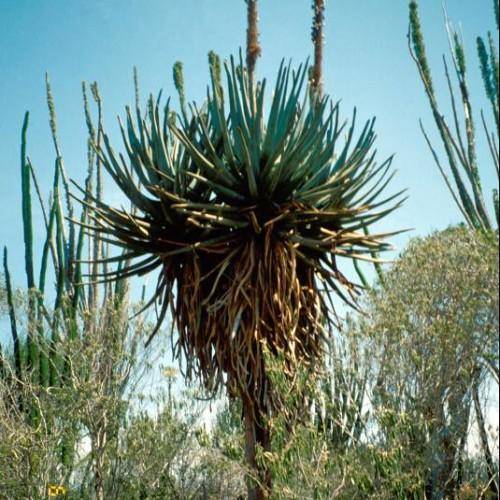
aloe
Aloe suzannae
Cycle:
Perennial
Watering:
Minimum
Hardiness Zone:
9 - 11
Flowers:
Flowers
Sun:
full sun,part sun/part shade
Leaf:
Yes
Growth Rate:
Low
Maintenance:
Low
Drought Tolerant:
Yes
Salt Tolerant:
Yes
Indoors:
Yes
Care Level:
Low
watering
Water Aloe suzannae no more than once every 2 weeks, using approximately 1/2 gallon of water per plant. This should be done in the morning before the sun comes out, to avoid root rot due to over-watering. During the hottest summer months, water approximately once a month, but increase the amount of water slightly. Additionally, always make sure that the soil is barely moist. If you water more often, only give a very small amount of water each time. Over-watering is the most common cause for Aloe Suzannae dying, so watch carefully for signs of overwatering, such as stunted growth and wilting.
sunlight
Aloe suzannae needs direct sunlight for about 5-6 hours per day. It should receive the sun's light in the morning and then again in the afternoon. The best location for an aloe suzannae plant is a spot that gets full sun in the morning and partial shade in the afternoon. Be aware that this plant should not be placed in direct, intense midday sunlight. Too much sunlight can cause the leaves to become scorched and discolored.
pruning
Pruning for aloe (Aloe suzannae) should be done at least once a year in early summer. Pruning should involve removal of dead leaves and flowers as well as pinching off any suckers that sprout off of the base of the plant. The aloe should only be pruned as much as necessary to keep the plant looking healthy and to maintain its shape.
Season
Hardiness Map
FAQ
Is Aloe Vera a succulent plant?
Yes, Aloe Vera is a type of succulent plant, meaning that it can hold large amounts of water in its leaves. Aloe Vera is one of the most popular succulent species, prized for its therapeutic properties and its low maintenance requirements. In addition to being a drought-tolerant plant, Aloe Vera is also highly resistant to pests and is easy to propagate.
Are Aloe Vera leaves used for medicinal purposes?
Yes, Aloe Vera leaves are used for medicinal purposes. The clear gel found inside the leaves has many healing properties and is commonly used to treat skin injuries, burns, cuts and other skin conditions. It is also known to provide relief from inflammation and can be used to soothe sunburns and eczema. Aloe Vera juice is also said to be helpful in aiding digestion, improving oral health and reducing blood sugar levels.
Can Aloe Vera grow well indoors?
Yes, Aloe Vera can certainly grow well indoors. In fact, it is an excellent choice for an indoor houseplant owing to its natural ability to thrive in places with limited light and its very low watering needs. Aloe Vera should receive bright light with at least 4 hours of indirect sunlight every day. It should be watered deeply when the soil feels dry to the touch (roughly every 2-3 days). It also prefers soil that has good drainage, so use a cactus/succulent potting mix. With just a little care, Aloe Vera can become a beautiful, easy to care for indoor plant.
Could Aloe Vera help soothe sunburns?
Yes, Aloe Vera can be an effective way to soothe sunburns. This is because it has anti-inflammatory qualities that work to reduce redness and swelling. It also contains substances that help protect the skin and promote healing. Applying a thin layer of Aloe Vera directly to the sunburn helps cool and enhance the skin's natural repair process. Additionally, it helps to replace moisture that has been lost due to sun exposure. Since Aloe Vera is all-natural, it can be an excellent home remedy for treating sunburns.
Should Aloe Vera be watered frequently?
Yes, Aloe Vera should be watered frequently. Aloe Vera plants prefer soil that is slightly dry and should receive regular watering whenever the top 1-2 inches (2.5-5 cm) of soil become dry. Water the plant thoroughly until water drains from the bottom of the pot. Allow the plant's soil to dry out before watering it again. Overwatering can be harmful, so it is important to make sure not to water your Aloe Vera too often. Additionally, it’s beneficial to mist the Aloe Vera's leaves with water during hot, dry periods.
Do Aloe Vera plants need a lot of sunlight?
Aloe vera plants require a moderate amount of direct sunlight. Depending on the variety, many species of aloe vera can thrive in either a sunny spot or partial shade. When it comes to sunlight, you don't want to overdo it! Exposing these plants to too much direct sunlight can damage their leaves. Ideally, these plants should receive 4-6 hours of bright, indirect sunlight.
